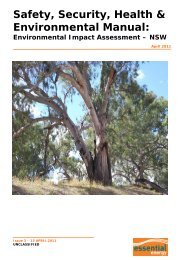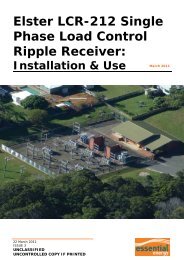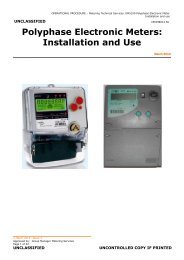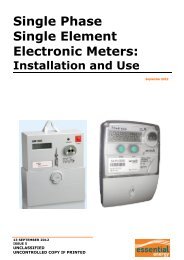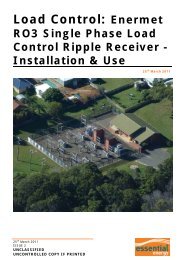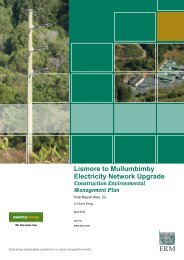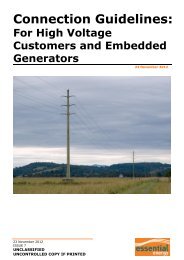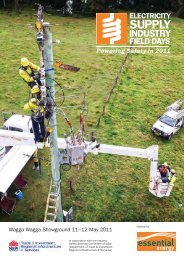Full Version - Essential Energy
Full Version - Essential Energy
Full Version - Essential Energy
You also want an ePaper? Increase the reach of your titles
YUMPU automatically turns print PDFs into web optimized ePapers that Google loves.
Notes to the Financial Statements<br />
for the year ended 30 June 2005<br />
(iv) Asset sales<br />
The gross proceeds of sale of assets is recognised as revenue and is brought to account when control of the asset passes<br />
to the buyer.<br />
(v) Capital contributions<br />
Capital contributions are monies paid by customers, or prospective customers, seeking an augmentation of the electricity and gas<br />
distribution systems in circumstances where, in the ordinary course of events, such augmentation would not be undertaken by<br />
Country <strong>Energy</strong>.<br />
Capital contributions are recognised as revenue in proportion to the stage of completion of the related augmentation works.<br />
Assets that are contributed to Country <strong>Energy</strong> by customers, are treated as capital contributions and are valued at fair value (refer<br />
note 1(h)(vi)).<br />
72<br />
(g) Valuation of Current Assets<br />
(i) Cash assets<br />
For the purposes of the Statement of Financial Position, cash assets include cash on hand and investments at call (refer note 7).<br />
For the purposes of the Statement of Cash Flows, cash includes cash assets net of bank overdraft (refer note 21).<br />
(ii) Receivables<br />
Trade debtors are carried at amounts due. Collectability of debt is assessed at balance date. A general provision is determined<br />
after having considered the ageing of the debt and the credit risk of the debtors (refer note 8).<br />
(iii) Investments<br />
Investments are recorded at cost. Any change in market value is recognised as revenue.<br />
(iv) Inventories<br />
Inventories have been valued at the lower of cost and net realisable value. Cost is determined using the average purchase price of<br />
each item and comprises the cost of purchase including the cost of bringing the inventories to their appropriate location. The major<br />
components of inventories are capital stores and consumables used in the maintenance of the distribution network.<br />
(h) Valuation of Property, Plant and Equipment<br />
(i) System assets<br />
The network system assets were valued as at 30 June 2005 by Sinclair Knight Merz an “Optimised Depreciated Replacement<br />
Cost” (ODRC) methodology.<br />
Theses assets were also valued by PricewaterhouseCoopers (PWC) using a “Discounted Cash Flow” (DCF) Methodology”.<br />
The carrying values of the system assets at balance date are supported by the independent valuations.<br />
Included as components of the system assets are generation assets. These assets are separately identifiable and their future cash<br />
flows can be reasonably determined. PWC carried out a DCF valuation of these assets resulting in the carrying value being written<br />
down by $1.470 million to the Statement of Financial Performance.<br />
(ii) Land and buildings<br />
The 30 June 2005 land and building asset values of Country <strong>Energy</strong> were valued by Colliers International Consultancy and<br />
Valuation Pty Limited (Colliers) using a “Fair Value” methodology. Colliers determined that the fair value was $88.633 million.<br />
In accordance with the Colliers valuation the carrying value of the assets has been increased by $14.658 million. The increase has<br />
been recorded in the asset revaluation reserve.<br />
(iii) Other plant and equipment.<br />
Country <strong>Energy</strong>’s other non-current physical assets comprise of non-specialised assets with short useful lives. Examples are<br />
motor vehicles, office equipment and computer equipment. These assets are disclosed at fair value which is equivalent to their<br />
depreciated historical cost. For this class of asset depreciated historical cost is an acceptable measure for fair value because the<br />
difference between theses valuations is unlikely to be material. The cost of obtaining an accurate fair value is not justified with<br />
regard to the potential benefits received.<br />
COUNTRY ENERGY ANNUAL REPORT 2004–2005




